Creating Variables
This page contains the following sections:
- Starting Variables Wizard
- Slider Variables (Continuous)
- Slider Variables (Discrete)
- Text Box Variables
- Radio Button Variables
Starting Variables Wizard
To access the various variable commands, click the Variables List icon in the Data Discovery/Analytics ribbon
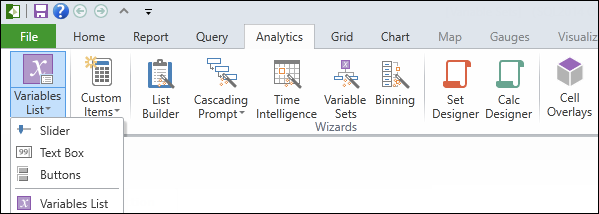
Slider Variables (Continuous)
The image below shows an example of how a continuous slider variable appears in the report workspace.

To create a continuous slider variable, you enter the default, min, max and incremental values. Once you enter the variable in a report, you can change its value at runtime by means of the slider.
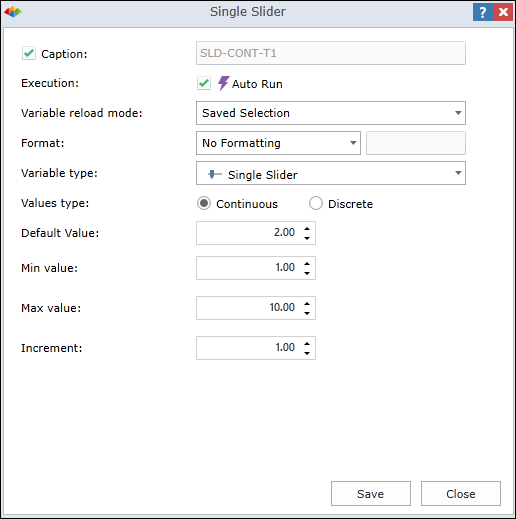
Caption – Type in a name for the variable you wish to create (in this example, "SLD-CONT-T1").
Execution – Check this box if you want the query to autorun each time you change the variable's value.
Variable reload mode – Choose one of the reload modes to determine what will happen when you exit a report and then later reload the report:
- Saved Selection - The system will reload the variable's value from the last save of the report. Note that each individual report is saved as part of the book in which the report is contained.
- Value - The system will reload the default value as specified in the Variables dialog.
Format – Select desired format from the list or specify your own custom format.
Variable Type – Select a variable type (in this example, "Single Slider").
Values type: Select the value type (in this example, "Continuous").
Default Value – Assign a default value to the variable.
Min Value – Specify the bottom value of the range.
Max Value – Specify the top value of the range.
Increment – Specify the increment to be used for changing the variable's value in runtime. For example, if you specify a range of 1-10 and an increment amount of 1, the variable can be any integer from 1 to 10. However, if the increment is .5, the variable can be any multiple of .5 in the 1.00 to 10.00 range (1.00, 1.50, 2.00, 2.50, etc.).
Save – Save changes and close dialog.
Close – Close dialog without saving changes.
Slider Variables (Discrete)
The image below shows an example of how a discrete slider variable appears in the report workspace.

To create a discrete slider variable, you enter a default value and several fixed values. Once you enter the variable in a report, you can toggle between the fixed values at runtime.
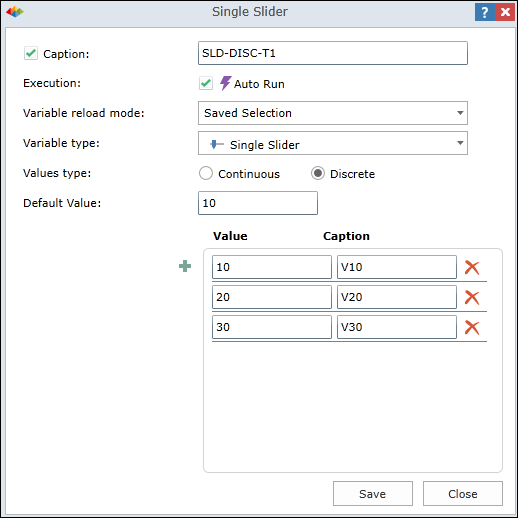
Caption – Type in a name for the variable you wish to create (in this example, "SLD-DISC-T1").
Execution – Check this box if you want the query to autorun each time you change the variable's value.
Variable reload mode – Choose one of the reload modes to determine what will happen when you exit a report and then later reload the report:
- Saved Selection - The system will reload the variable's value from the last save of the report. Note that each individual report is saved as part of the book in which the report is contained.
- Value - The system will reload the default value as specified in the Variables dialog.
Variable Type – Select a variable type (in this example, "Single Slider").
Values type: Select the value type (in this example, "Discrete").
Default Value – Specify a default value for the variable. The default value MUST match one of the values in the Value/Caption Pairs.
Value/Caption Pairs - Each pair contains a fixed value and its associated caption. Use the green plus icon + to add a pair. Use the red X icon to delete a pair.
Save – Save changes and close dialog.
Close – Close dialog without saving changes.
Text Box Variables
The image below shows an example of how a text box variable appears in the report workspace.

Text box variables provide a simple interface for changing the variable's value freely in runtime.
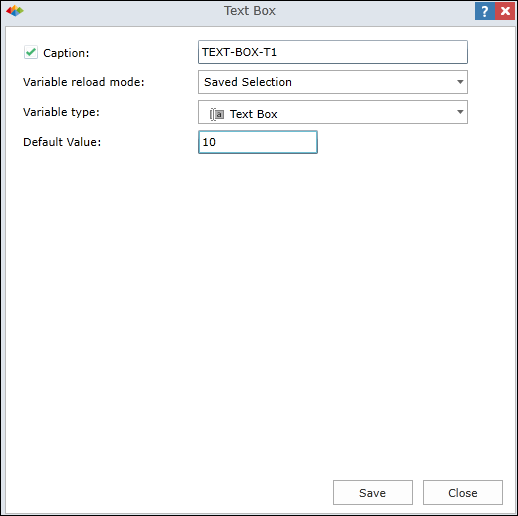
Caption – Type in a name for the variable you wish to create (in this example, "TEXT-BOX-T1").
Variable reload mode – Choose one of the reload modes to determine what will happen when you exit a report and then later reload the report:
- Saved Selection - The system will reload the variable's value from the last save of the report. Note that each individual report is saved as part of the book in which the report is contained.
- Value - The system will reload the default value as specified in the Variables dialog.
Variable Type – Select a variable type (in this example, "Text Box").
Default Value – Specify a default value for the variable.
Save – Save changes and close dialog.
Close – Close dialog without saving changes.
Radio Button Variables
The image below shows an example of how a radio button variable appears in the report workspace.

To create a radio button variable, you enter a default value and several fixed values. Once you enter the variable in a report, you can toggle between its fixed values at runtime.
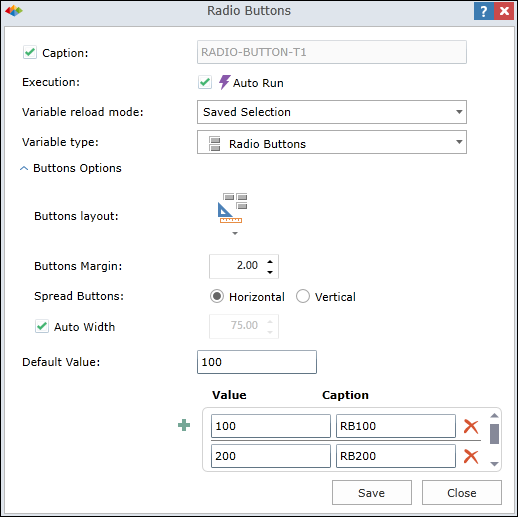
Caption – Type in a name for the variable you wish to create (in this example, "RADIO-BUTTON-T1").
Execution – Check this box if you want the query to autorun each time you change the variable's value.
Variable reload mode – Choose one of the reload modes to determine what will happen when you exit a report and then later reload the report:
- Saved Selection - The system will reload the variable's value from the last save of the report. Note that each individual report is saved as part of the book in which the report is contained.
- Value - The system will reload the default value as specified in the Variables dialog.
Variable Type – Select a variable type (in this example, "Radio Buttons").
Buttons Options:– Display/hide button options.
Buttons Layout – Choose the number of columns to display. For example, assuming you have six buttons defined:
- Choosing THREE columns will display two buttons in each of the three columns.
- Choosing ONE column will display all six buttons in a single column.
Buttons Margin - Enter a value in the 0-100 range to change the button-to-margin ratio:
- Enter 0 for large buttons and small margins.
- Enter 100 for small buttons and large margins.
Spread Buttons – Choose Horizontal to arrange the buttons horizontally. Choose Vertical to arrange the buttons vertically.
Auto Width – Check/uncheck this box to control the overall rectangle containing the buttons:
- Check this box to arrange buttons within a flexible rectangle that changes size automatically.
- Uncheck this box and enter a value in the 1-200 range to arrange buttons within a fixed rectangle.
Default Value – Enter a default value for the variable. The value MUST match one of the values in the Value/Caption Pairs.
Value/Caption Pairs - Each pair contains a fixed value and its associated caption. Use the green plus icon + to add a pair. Use the red X icon to delete a pair.
Save – Save changes and close dialog.
Close – Close dialog without saving changes.
Home |
Table of Contents |
Index |
User Community
Pyramid Analytics © 2011-2022

